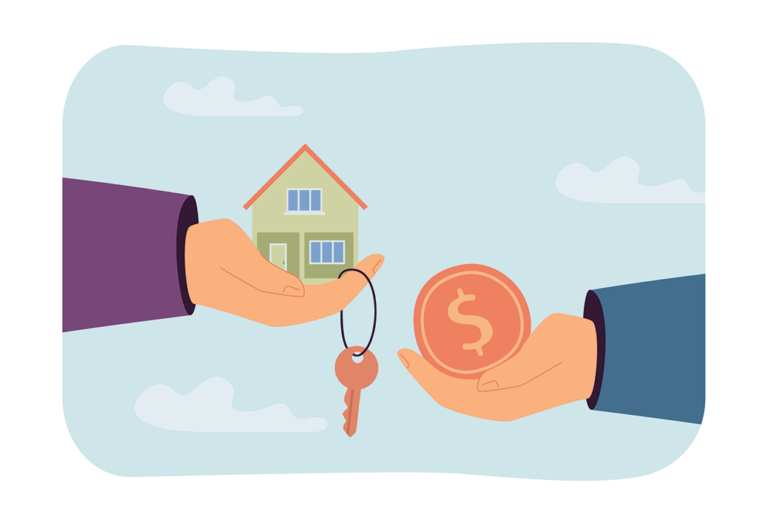Understanding the nuances of financing can be the difference between a profitable venture and a missed opportunity. One term that often pops up, especially for those looking to finance a fixer-upper with a hard money loan, are points. But what exactly does this mean, and why is it crucial for real estate investors to grasp?
Hard money loans have become a go-to for many investors, especially when traditional financing routes aren’t feasible or quick enough. These loans offer flexibility and speed, but they come with their own set of terms and costs. Among these costs are points.
In this article, we’ll explore hard money loan points, shedding light on their significance, how points are calculated, and what investors should expect. So, let’s get started!
What is a Hard Money Loan?

Navigating the real estate market as an investor requires a keen understanding of the various financing tools. Among these, hard money loans stand out as a unique and often invaluable resource for investors. But what sets them apart?
At its core, a hard money loan is a short-term loan primarily based on the projected after-repair value of the purchased property rather than the borrower’s creditworthiness. Unlike traditional bank loans, which focus heavily on the borrower’s credit score and income, hard money lenders are more concerned with the property’s value and potential after repairs or renovations.
Here’s why many real estate investors turn to hard money loans:
- Speed: Traditional loans can take weeks or even months to get approved. In contrast, hard money loans can often be secured in days, making them ideal for investors looking to capitalize on time-sensitive deals.
- Flexibility: Often private entities or individuals, hard money lenders can offer more flexible terms and conditions than institutional lenders. This flexibility can be a boon for unique projects or unconventional properties.
- Asset-based: The loan amount is primarily determined by the property’s after-repair value. This means that even if an investor has a less-than-stellar credit history, they can still secure financing if the property holds promise.
However, with these benefits come certain costs, and one of the most prominent among them are hard money loan points. As we explore this topic further, it’s essential to understand how these points fit into the broader landscape of hard money lending and why they matter to investors.
Related: How to Refinance a Hard Money Loan.
What are Hard Money Loan Points?
When shopping around for a hard money loan, the term “points” frequently emerges, often leading to a flurry of questions. In essence, these points are pivotal in determining the cost of obtaining a hard money loan. But let’s break it down further.
Hard money loan points are upfront fees that a borrower pays the lender at closing. Each point typically represents 1% of the total loan amount. For instance, if you’re securing a $500,000 loan and the lender charges 2 points, you’d be looking at an upfront fee of $10,000.
But why do these points exist? They serve multiple purposes:
- Compensation for the Lender: Hard money loans are riskier than traditional loans. The points act as immediate compensation for the lender, given the higher risk they’re taking on.
- Loan Customization: Points can sometimes be negotiated. A borrower might pay more points upfront for a lower interest rate over the loan’s lifespan.
- Covering Operational Costs: Lenders often use points to cover the costs associated with underwriting and processing the loan, ensuring they remain profitable even if the loan is repaid quickly.
Points can directly impact the overall cost of financing, and being savvy about them can lead to better negotiation and more favorable loan terms. As we progress, we’ll explore how these points are calculated and the various types associated with hard money loans.
How are Points Calculated?

As mentioned earlier, a point typically represents 1% of the total loan amount. But how does this translate in real-world scenarios?
Basic Calculation:
To determine the cost of points:
- Identify the total loan amount.
- Multiply the loan amount by the number of points (expressed as a decimal).
Example:
Let’s say you’re securing a loan of $300,000, and your lender charges 3 points.
Calculation:
$300,000 x 0.03 (which is 3% or 3 points) = $9,000
In this scenario, you’d pay $9,000 in points.
Factors Influencing Points:
While the basic calculation remains consistent, the number of points charged can vary based on several factors:
- Loan Size: Smaller loans might have higher points since the lender wants to ensure profitability on a smaller loan.
- Perceived Risk: If the lender perceives the loan as riskier due to the property’s condition or the borrower’s financial situation, they might charge more points.
- Lender’s Policy: Different lenders have different policies. Some might have a flat rate, while others adjust points based on the deal’s specifics.
- Negotiations: A borrower with a strong track record or a particularly promising property might be able to negotiate a reduction in points.
Understanding how points are calculated and the factors influencing their number is paramount. It helps investors anticipate the upfront costs and equips them to negotiate better terms and potentially save thousands in the process.
Related: Loan-to-Value Ratio: What is it? And Why it Matters and Loan-to-Cost Ratio.
Different Types of Points on a Hard Money Loan
When discussing hard money loan points, it’s essential to recognize that not all points are created equal. They can serve different purposes and have a varying impact on the loan’s overall cost. Let’s look at the primary types of points you might encounter.
Discount Points
Discount points are a form of prepaid interest. By paying these points upfront, borrowers can secure a lower interest rate on their loan, which can lead to significant savings over the loan’s duration.
- How They Work: For every discount point purchased, the loan’s interest rate is typically reduced by a certain percentage, often around 0.125% – 0.25%.
- Benefits: They can be especially advantageous for longer-term loans where the reduced interest rate can lead to substantial savings.
- Considerations: It’s crucial to calculate the break-even point where the interest savings outweigh the upfront cost of purchasing the discount points.
Origination Points
Origination points, or loan origination fees, are charged by lenders and brokers to cover the costs associated with processing the loan. This includes underwriting, verifying borrower information, and preparing loan documents.
- How They Work: These points allow lenders to be compensated for the work and resources they invest in initiating the loan.
- Benefits: While it might seem like just another fee, origination points can sometimes be negotiated, especially if the lender wants to secure the deal.
- Considerations: It’s essential to compare origination points among different lenders. While one lender might have a lower interest rate, they might charge higher origination points, affecting the loan’s overall cost.
Both discount and origination points play pivotal roles in the structure of a hard money loan. As always, it’s advisable to consult with a trusted lender to navigate the process effectively.
How Many Points Should You Expect to Pay?
As a real estate investor venturing into hard money loans, one of the most pressing questions is: “How many loan points should I anticipate paying?” While there’s no one-size-fits-all answer, understanding industry norms and the factors influencing these points can provide clarity.
Average Range:
Typically, hard money lenders charge between 1 to 5 points on a loan. However, this range can vary based on several factors:
- Geographical Location: In some real estate markets, competition among hard money lenders might be fierce, leading to lower points. In contrast, in areas with fewer lenders, the points might be on the higher end.
- Loan Amount: Lenders might charge fewer points for larger loans as the absolute dollar amount they receive is still significant. Conversely, smaller loans might have higher points to ensure the lender’s profitability.
- Loan-to-Value (LTV) Ratio: A higher LTV, indicating the borrower is financing a significant portion of the property’s value, might result in higher points due to increased risk.
Factors Influencing Points:
- Borrower’s Experience: Seasoned real estate investors with a track record of successful projects might be able to negotiate lower points.
- Loan Duration: As mentioned earlier, shorter-term loans might come with higher points to ensure the lender’s profitability in a limited timeframe.
- Lender’s Business Model: Some lenders might prioritize volume over margins, charging fewer points but processing more loans. Others might focus on fewer, high-margin deals.
While the range of 1 to 5 points provides a general guideline, the exact number of hard money loan points an investor should expect to pay is influenced by a combination of market dynamics, the specifics of the deal, and the lender’s policies. It’s always advisable to shop around (or have a broker do that for you!), compare terms from various lenders, and negotiate when possible. Being proactive and informed can yield more favorable loan terms and substantial savings!
Pros and Cons of Hard Money Loan Points
While it can be hard to imagine any advantages of paying points on a hard money loan, stick with me for a second:
Pros of Hard Money Loan Points:
- Potential for Lower Interest Rates: By paying more points upfront, especially discount points, borrowers can often secure a lower interest rate, leading to long-term savings.
- Flexibility in Loan Structuring: Points offer a way to customize the loan. Investors can negotiate the number of points in exchange for other terms, like eliminating a prepayment penalty.
Cons of Hard Money Loan Points:
- Increased Upfront Costs: Points add to the initial expenses of securing a loan. This increase in your cost-basis can make reaching your target return on investment harder. When underwriting a potential deal, it’s essential to factor in loan point costs to get a clear picture of your projected profit.
- Potential for Overpayment: If not careful, the perceived benefit of paying discount points might cost more than what you’ll save in interest or other loan terms.
As an investor, assessing your situation, project timeline, and financial standing is important. By doing so, you can determine whether the points structure of a particular hard money loan aligns with your objectives.
When are Hard Money Loan Points Due?

With “brokers” and “private lenders” popping up on Facebook and other social media platforms by the minute, there are some bad actors out there. If a financing deal sounds too good to be true, it probably is. Should a lender or broker tell you that origination points are due before the loan even closes, you must back away and run away as fast as possible! The only time money should be exchanged between yourself and your lender or broker is at the closing table!
Payment of Points:
- At Closing: Most commonly, hard money loan points are due at the loan’s closing. When the loan is finalized, and funds are disbursed, the borrower pays the points.
- Rolling into the Loan: Sometimes, lenders might allow borrowers to roll the points into the total loan amount. While this reduces the upfront cash needed, it increases the loan’s principal and, consequently, the interest paid over time.
Factors Influencing the Payment of Points:
- Lender’s Policy: Different lenders have varying policies. Some might insist on payment at closing, while others might offer more flexibility.
- Loan Duration: For shorter-term loans, lenders prefer to receive points upfront at closing to ensure they achieve a certain profitability level quickly.
- Borrower’s Negotiation: Experienced investors might be able to negotiate the timing of point payments, especially if they have a longstanding relationship with the lender.
- Loan Amount: For larger loans, lenders might be more flexible with the timing of point payments, given the overall profitability of the deal.
Things to Consider:
- Liquidity: This might be a given, but as an investor, you should assess your liquidity and ability to cover the points when due. Being short at the closing table is no fun!
- Total Loan Cost: If you’re considering rolling points into the loan, calculate the long-term implications, including increased interest payments.
Now, let’s go over some frequently asked questions.
Frequently Asked Questions
Hard money loan points are upfront fees, typically representing 1% of the loan amount per point, charged by lenders to compensate for the risk and operational costs of the loan.
While both types of points represent a percentage of the loan amount, hard money loan points often relate to the loan’s risk and short-term nature, whereas traditional mortgage points usually offer borrowers a reduced interest rate.
Yes, the number of points can often be negotiated based on the lender’s policies.
Points increase the upfront cost of securing the loan, and if not offset by other favorable terms, they can raise the overall cost of borrowing.
Yes, there are primarily discount points, which can lower your interest rate, and origination points, which cover the lender’s processing costs; the exact impact on interest rates varies by lender and negotiation.
The Wrap Up
While points are just one component of hard money loans, they hold significant weight in financing a fixer-upper. Their impact on a loan’s overall cost, flexibility, and structure can make or break an investment deal.
Key Takeaways:
Every Deal is Unique: While industry norms provide guidance, each real estate deal is unique. Factors like loan amount, borrower experience, and lender policies can influence the number and type of points charged.
Negotiation is Key: Armed with knowledge and a clear understanding of their financial position, investors can and should negotiate. Whether it’s the number of points, the interest rate, or the payment timeline, every aspect can potentially be tailored to suit the investor’s needs better.
Seek Expertise: The world of real estate financing is vast and complex. Don’t hesitate to consult with financial experts, experienced peers, or trusted lenders. Their insights can be invaluable in navigating the intricacies of hard money loans and other financing aspects.
For those looking to dive deeper into real estate financing or seeking personalized guidance, reach out to our team of experts. We’re here to assist, whether it’s understanding how hard money loan points can affect your deal, comparing loan offers, or strategizing for your next big investment. Let’s turn knowledge into actionable steps in your real estate journey.